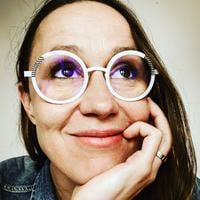Students often say that they live in a family house. This is not a common English collocation, however. Instead you should say you live in a detached house, i.e. one not joined to another house on either side. There are, of course, some other types of houses, e.g. a bungalow, i.e. a house built all on one level, or a terraced house, i.e. one in a row of several houses joined together on each side. You can use expressions such as a single-storey house, a two-storey house, etc., if you want to specify the number of floors in your house. We use the noun storey (usually spelled story in American English) mainly when we are talking about the number of levels a building has. The noun floor is used mainly to talk about which particular level in the building someone lives on. We normally don’t include a basement in the number of storeys/floors.
Another type of house is a semi-detached house, or a semi for short. It is often translated into Slovak as dvojdom – however, such an equivalent doesn’t reflect the extra-linguistic reality accurately. The prefix semi- means half or partly, and the adjective semi-detached means joined to another house by one shared wall. So a semi-detached house is half of our dvojdom, and our dvojdom is a pair of two semi-detached houses. The two halves of our dvojdoms are usually more or less identical, but a semi-detached house doesn’t necessarily have to be the same as its neighbouring counterpart. It is simpler for us in American English, in which a building divided into two separate homes is called a duplex. Another meaning of duplex is an apartment (a flat) with rooms on two floors.
A similar problem arises with the translation of the compound bunk bed. Some bilingual dictionaries translate it as poschodová posteľ. A bunk bed, however, is one of two beds that are fixed together, one above the other. So our poschodová posteľ is a pair of bunk beds, in fact. Do not confuse it with a double bed, which is a large bed for two people, usually a husband and wife, to sleep on. A marriage bed is the bed a husband and wife sleep on the first night after their wedding. A twin bed is one of a pair of single beds in a room. In a hotel, two people can be accommodated together either in a double room (a room with a double bed) or in a twin room (a room with two single beds).
Students sometimes use the invented expression children’s room. The room in which you sleep, do your homework, relax, etc., is simply your room or your bedroom. In some big houses we can find a playroom, i.e. a room for children to play in, but not usually to sleep in.
There are also differences between what the British and Americans call the area around a house and its parts. A garden is normally translated into Slovak as záhrada. In American English, a garden actually is an area where people grow flowers, fruit and/or vegetables, but in British English, it is the whole area next to or around a house. So when you read the sentence ‘The children were playing in the garden,’ it probably doesn’t mean that they were playing somewhere in the middle of strawberry beds. In the USA, a yard is what the British call a garden, while in the UK, it is an area outside a public building (e.g., a school yard). A backyard is the back part of a garden/yard. In British English, it is an area with a hard surface behind a house (usually a lawn and/or pavement), while in American English, it is the whole area behind a house (including the lawn/paving and the garden), which the British call a back garden. British English also uses the compound kitchen garden, which is the part of a garden where people grow vegetables and fruit for their own use. In front of some houses is a front garden, which usually has grass and/or flowers.
The ground floor of some houses has a platform with an open front covered by a roof where people can relax. It is called a veranda (also spelled verandah) in British English and usually a porch in American English. A porch, however, is also a small area at the entrance to a building covered by a roof and often having walls.
A row of bushes or small trees planted close together and usually along the edge of a garden/yard is not called a live fence, as the word-for-word translation from Slovak would suggest. It is a called a hedge or hedgerow.
You probably already know that most people in towns and cities live in flats (BrE) / apartments (AmE). An apartment is also a set of rooms rented for a holiday (BrE) / vacation (AmE), and apartments are also rooms in a large, usually famous house. A large building with flats/appartments on each floor is called a block of flats / apartment block (BrE) / apartment building / apartment house (a small apartment building) (AmE).
Well, that’s it for this month’s issue. I hope you are not more confused about housing vocabulary than you were before reading this article.






